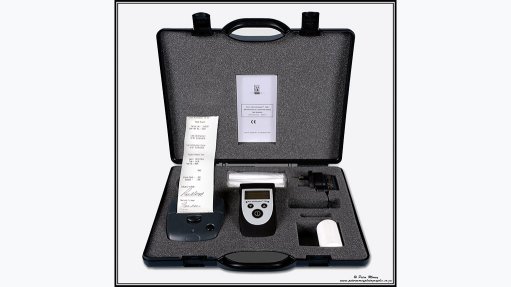Huge projected platinum deficit points to supply need beyond mining and recycling

World Platinum Investment Council Research Director Edward Sterck interviewed by Mining Weekly's Martin Creamer. Video: Darlene Creamer.
JOHANNESBURG (miningweekly.com) – The platinum deficit prediction for this year is up 77% to close to a million ounces.
This year’s platinum deficit is projected to be a record 983 000 oz amid consistently growing industrial demand on course to becoming the strongest on record, boosted 17% by glass capacity expansions.
Moreover, higher loadings and increased substitution of platinum for palladium have pushed up automotive demand by 12%, with stronger-than-expected positive investment demand resulting in an upped full-year forecast well beyond the 400 000 oz mark.
Rest-of-year platinum market indications are pointing to the need to secure platinum supplies beyond the two main sources of primary mining output and recycled collection.
Over the last five years, between 73% and 77% of total annual platinum supply in refined ounces has come from mining but the biggest deficit in ounce terms now points to demand having to be met from sources other than mined and recycled platinum.
That means effectively liberating platinum from above-ground stocks, but still unclear is exactly what pricing levels are needed to do that.
Amid platinum’s great projected supply fall and big projected demand rise, Mining Weekly put these questions to World Platinum Investment Council (WPIC) research director Edward Sterck. (Also watch attached Creamer Media video.)
Mining Weekly: Your latest Platinum Quarterly indicates that overall first-quarter supply remained constrained and is forecast to remain flat for the full year. What are the downside risks to mined supply in 2023 and what are the other risks to supply?
Sterck: There are a number of challenges facing mine supply at the moment. In South Africa specifically, obviously, there's the electricity shortage, and then more broadly, there have been some operational difficulties at some operations in North America, including some damage to shafts at an operation in Montana. Then in Russia, Nornickel is having to try and navigate its way through the headwinds posed by Western enacted sanctions against Russia. The mine supply projections we've put out for 2023 include an element of all those challenges. If you aggregate guidance, the supply projections are towards the bottom end of the aggregate guidance range that's published by all the companies involved. But that said, if, for example, the power shortage in South Africa continues to worsen and accelerate through the winter months, which are obviously the period for peak electricity demand in South Africa, then yes, there are further potential supply risks to the downside by anywhere between 5% and 15%, so potentially, several 100 000 oz lower than currently projected.
What is drawing investors back to platinum and to what extent will the recessionary environment help or hinder the return of increased platinum investment demand?
If we think about the retail investors, they're driven by preservation of capital during periods of uncertainty. Certainly, the banking crisis that has enveloped parts of North America, and more broadly, has driven a certain degree of interest in buying platinum bars and coins on the retail side, and that buying can be quite material. On the institutional investor side, the motivations are a little bit different. If we think back over the last couple of years, we've seen quite significant outflows from ETFs and those outflows have been driven by two factors. Firstly, investors in South Africa generally had a preference for the mining equities over the metal on expectations of being paid significant dividends by the mining companies. Those expectations certainly came to fruition, and it was arguably a sensible trade there. Then secondly, investors more broadly have been looking for yield. A metal ETF is a non-yielding asset and with rising real interest rates, investors have been compelled to look elsewhere. But in terms of what's bringing them back, within South Africa the challenges facing the mining industry mean that those super dividends may not be so super over the next couple of years, so South African investors are arguably more interested in the metal for their platinum exposure now than the equities, for the time being at least. Certainly, in the ETF flows, we can see that. We've seen significant flows into the South African ETFs whilst there have still being outflows from the North American and European ETFs. The other factor at play here, of course, is we're projecting a record deficit of almost a million ounces of platinum this year and as knowledge of that projection spreads, it's quite possible we'll see the investor interests reverse in Europe and North America as well, and the potential for positive ETF inflows in those geographies too, which could potentially add to the tighteness of the markets and broaden the deficit further.
This year is forecast to be a record year for industrial demand for platinum. What are the forces driving this?
There are a couple of things. Industrial demand is principally being driven, I guess, by some capacity additions in the chemical space in China, and also glass capacity additions, so we're seeing a quite significant year-on-year increase in industrial demand. That said, I should say that industrial demand has grown consistently. It does vary from year to year but in terms of the compound annual growth rate, it’s been around 5.2% growth since 2010, and I don't see any reason for that pace of growth to change on average going forward. Then, it's also being driven by strong demands from the automotive space. We're again seeing increasing substitution of platinum for palladium in gasoline vehicles and the emissions legislation has tightened in terms of platinum-containing exhaust treatment systems, with gains in market share in the heavy duty and off-road segments. So, there's significant growth in demand in both the automotive and industrial space. The only area that's a little bit more challenged perhaps is jewellery, which we're forecasting to be down 2% year on year, so let's call it broadly flat. But effectively within jewellery, we're seeing continued decline in demand from China, despite the Covid reopening, and that's been just about offset by growth in the rest of the world, particularly in India, where we're seeing platinum jewellery take quite significant strides forward in terms of consumer demand, with more shop space dedicated to it, and double-digit year-on-year growth for the last couple of years now.
Automotive demand for platinum has continued to grow. What are the main drivers of this?
It's largely that substitution story but also the loadings for heavy duty and non-road vehicles and on the side of substituting platinum for palladium in internal combustion engines. Effectively, you can substitute them on a one-to-one basis, so whilst there is a significant pricing differential between platinum and palladium, the motivation for the automakers to continue to substitute remains very much in place, and remember that once the substitution has occurred, it's locked in for the seven-year life of each vehicle platform. It's typically very unusual for automakers not to do that. I think there's only one example we've been able to find, where after the model has been certified, it has later gone back and been recertified for a different sort of ratio of platinum, palladium and rhodium in its exhaust treatment system. It's pretty much locked in so even if platinum and palladium were to return to par in terms of pricing today, we would expect the substitution story to continue to run for some time to come. The other thing in automotive demand is fuel cell electric vehicles (FCEVs). Now, the numbers are very small today, but they potentially could be more material in the future. We're expecting FCEVs to have roughly 1% market share by 2030, so pretty de minimis in the greater scheme of things, but the platinum demand for that is substantial. That 1% market share would equate to around a million ounces of demand by 2030, which out of total automotive demand at the moment around 3.8-million ounces off the top of my head, it's quite a big number.
Will the green investment case for platinum get stronger this year?
It's a slow and steady story of a small starting point that will accelerate quite dramatically in future years, but certainly, we’re seeing increasing demand from the hydrogen economy for platinum, and this is both for proton exchange membrane (PEM) electrolysers that produce hydrogen using renewable electricity, and then also the small but growing number of FCEVs on the road. In terms of demand, that’s potentially quite a big pool that will come from the hydrogen economy in time, but this year, in terms of the supply:demand dynamics, it's pretty small. That said, if we think about this from an investment point of view, the investor interest in green hydrogen is a key cornerstone, if you like, of global decarbonisation, along with many other technologies. There are limited opportunities to gain exposure to that, so in a strange way, even though the numbers this year are quite small, given that the market’s going to be in a deficit, any small changes from a new end source of demand, can have outsized effects on the market, so investor interest in platinum as a proxy for green hydrogen, which is growing and getting quite meaningful even though the demand might not be there right now in terms of the commodity.
What should be the main takeaway from this interview?
The thing to re-emphasise is that this is a record deficit. It's almost a million ounces. It's the biggest deficit in our time series, and if you look back through other time series that go back to the 1970s, it's the biggest deficit in ounce terms at least, so roughly 12% of demand this year, has to be met from sources other than mined or recycled platinum. That means effectively liberating platinum from above-ground stocks. What is unclear to me exactly is what pricing levels are needed to attract those ounces into the market. We're setting up to be looking at a really interesting platinum market through the rest of the year with a record deficit, and a need to secure platinum supplies from elsewhere.
REFINED MINED PRODUCTION OF PLATINUM
First-quarter refined mine production of platinum declined 8% year-on-year and 11% compared with the last quarter of last year, as gains from Russia failed to offset reduced output from South Africa. Output in South Africa declined 14% year-on-year and global first-quarter recycling of platinum fell 12% year-on-year to 413 000 oz.
Amid an uncertain economic and interest rate environment, banking turmoil, inflationary headwinds, and a global energy crisis, platinum is forecast to see a sustained period of deficit.
Importantly, the core drivers of platinum’s expected 28% demand growth in 2023 are areas where the downside risks are well protected.
The link between platinum and the hydrogen economy is becoming more widely recognised by investors. Platinum’s use in electrolysers producing green hydrogen for Europe’s future energy security is bolstering green hydrogen production and enhancing its role in global decarbonisation. Hydrogen-related platinum demand is expected to grow substantially in the medium term, and as hydrogen demand becomes meaningful, platinum could become a proxy for investors looking for exposure to the global decarbonisation journey, WPIC stated in a release to Mining Weekly.
JUMP IN INVESTMENT DEMAND
First-quarter bar and coin investment jumped by 71% year-on-year to 102 000 oz, propelled by a marked recovery in Japan. An increase of 79% is forecast for the full year. Net platinum ETF holdings reversed the previous six quarters of net disinvestment. The trend of holding platinum ETFs in preference to platinum mining equities is expected to continue in 2023. The result will mean net investment demand of 433 000 oz in 2023, a swing of 1 073 000 oz on 2022.
Article Enquiry
Email Article
Save Article
Feedback
To advertise email advertising@creamermedia.co.za or click here
Press Office
Announcements
What's On
Subscribe to improve your user experience...
Option 1 (equivalent of R125 a month):
Receive a weekly copy of Creamer Media's Engineering News & Mining Weekly magazine
(print copy for those in South Africa and e-magazine for those outside of South Africa)
Receive daily email newsletters
Access to full search results
Access archive of magazine back copies
Access to Projects in Progress
Access to ONE Research Report of your choice in PDF format
Option 2 (equivalent of R375 a month):
All benefits from Option 1
PLUS
Access to Creamer Media's Research Channel Africa for ALL Research Reports, in PDF format, on various industrial and mining sectors
including Electricity; Water; Energy Transition; Hydrogen; Roads, Rail and Ports; Coal; Gold; Platinum; Battery Metals; etc.
Already a subscriber?
Forgotten your password?
Receive weekly copy of Creamer Media's Engineering News & Mining Weekly magazine (print copy for those in South Africa and e-magazine for those outside of South Africa)
➕
Recieve daily email newsletters
➕
Access to full search results
➕
Access archive of magazine back copies
➕
Access to Projects in Progress
➕
Access to ONE Research Report of your choice in PDF format
RESEARCH CHANNEL AFRICA
R4500 (equivalent of R375 a month)
SUBSCRIBEAll benefits from Option 1
➕
Access to Creamer Media's Research Channel Africa for ALL Research Reports on various industrial and mining sectors, in PDF format, including on:
Electricity
➕
Water
➕
Energy Transition
➕
Hydrogen
➕
Roads, Rail and Ports
➕
Coal
➕
Gold
➕
Platinum
➕
Battery Metals
➕
etc.
Receive all benefits from Option 1 or Option 2 delivered to numerous people at your company
➕
Multiple User names and Passwords for simultaneous log-ins
➕
Intranet integration access to all in your organisation















